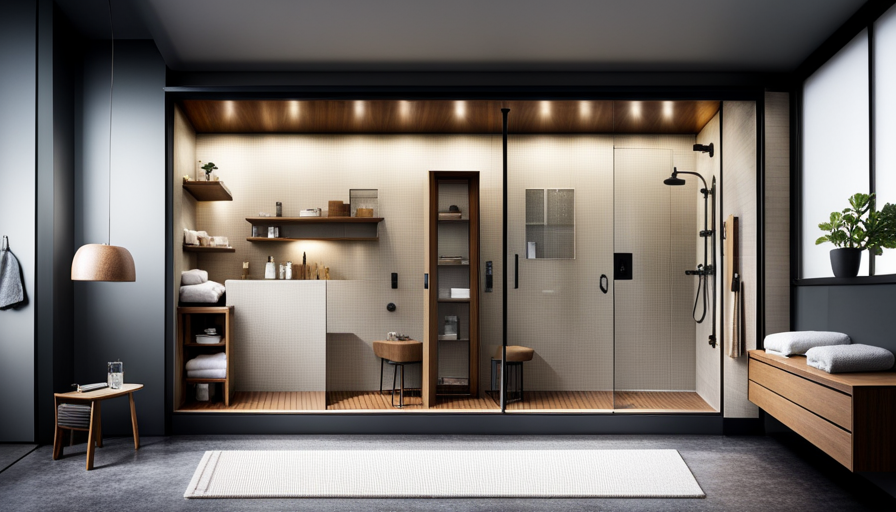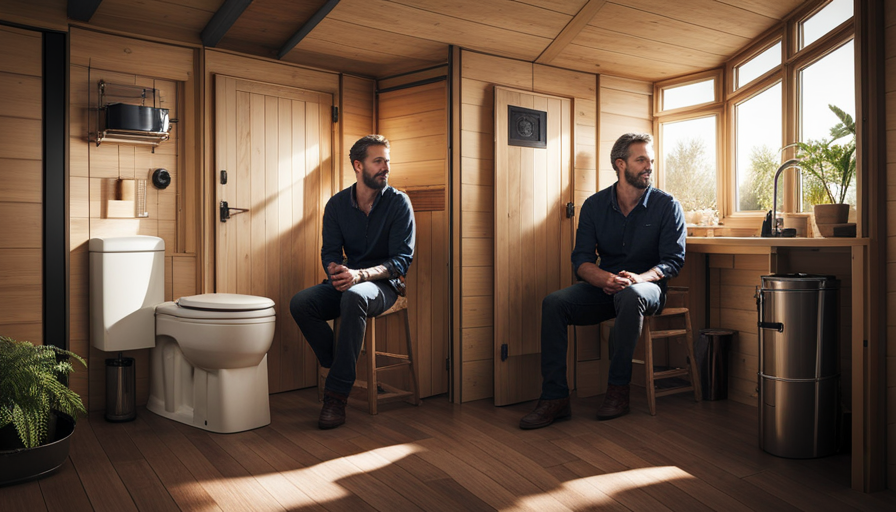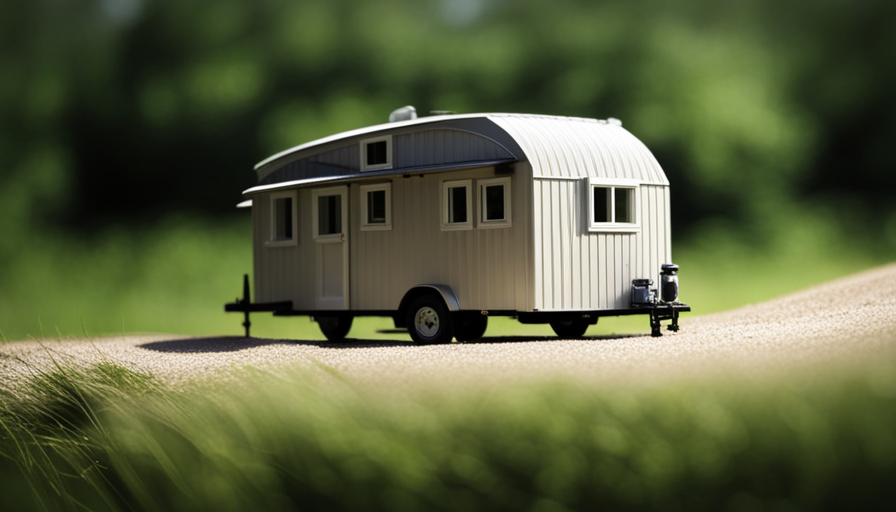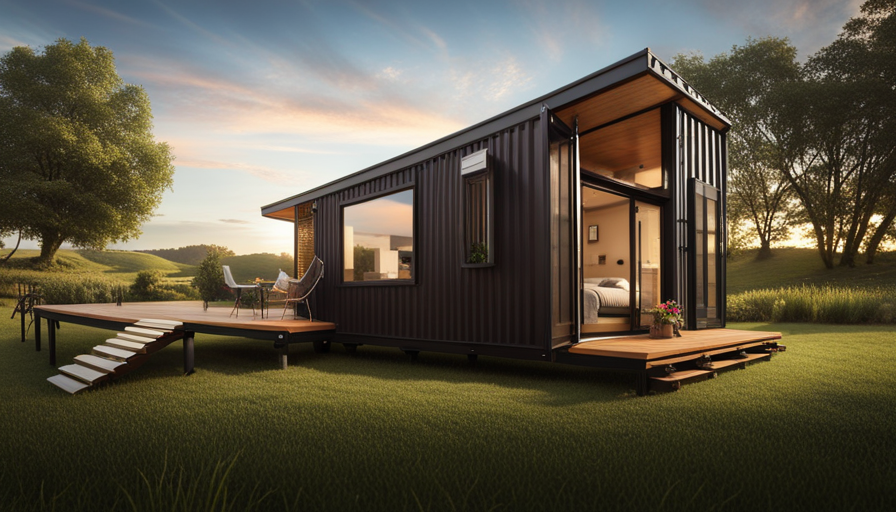Are you ready to discover the secret to showering in a tiny home? Get ready to maximize your space and make the most of every inch, as I share the ultimate guide on showering in compact living spaces.
Picture this: stepping into a shower that perfectly fits your needs, with clever design elements that make every drop of water count. Imagine the satisfaction of having storage solutions that keep your toiletries organized and easily accessible. And don’t forget the privacy, because we’ve got you covered there too.
With alternative showering options and low-maintenance materials, you’ll be able to enjoy a refreshing shower experience without the hassle. Plus, I’ll share my top tips for cleaning and maintenance, so your tiny house shower stays pristine.
So, are you ready to dive into the world of tiny house showering? Let’s make a splash together!
Key Takeaways
- Maximize every square inch of space in the tiny house shower by utilizing clever design elements and alternative low-maintenance showering options.
- Regularly clean and maintain the shower by wiping down walls and floor, cleaning the showerhead and unclogging drains, and addressing plumbing issues promptly.
- Choose the right shower design for the tiny house by evaluating space, considering layout, size, and shape, and exploring options like corner showers, walk-in showers, and shower-tub combinations.
- Optimize water usage and plumbing in the tiny house shower by installing low-flow showerheads and faucets, considering a greywater recycling system, and timing showers to minimize water consumption.
Evaluate Your Space and Choose the Right Shower Design
Before you start designing your tiny house shower, take a moment to envision the perfect oasis that’ll fit seamlessly into your limited space. When it comes to maximizing space and minimizing water usage, there are a few key factors to consider in order to create a functional and efficient shower design.
Firstly, think about the layout of your tiny house and evaluate the available space. Measure the area where you plan to install the shower and take note of any obstacles or limitations. This’ll help you determine the size and shape of the shower that’ll work best for your needs.
Next, consider the type of shower enclosure that’ll fit within your space. There are various options to choose from, including corner showers, walk-in showers, and shower-tub combinations. Each design has its own advantages, so think about what’ll work best for you in terms of space and functionality.
Additionally, think about ways to optimize water usage and plumbing. Consider installing low-flow showerheads and faucets to minimize water consumption. You can also incorporate water-saving features such as a shower timer or a greywater recycling system.
By carefully evaluating your space and choosing the right shower design, you can create a functional and efficient oasis in your tiny house. Now, let’s move on to the next section, where we’ll explore how to optimize water usage and plumbing in your tiny house shower.
Optimize Water Usage and Plumbing
To fully maximize water efficiency and plumbing in your cozy abode, consider implementing innovative techniques that will not only preserve this precious resource but also enhance your overall showering experience. When it comes to water-saving techniques, there are several strategies you can employ in your tiny house.
-
Install a low-flow showerhead: These showerheads are designed to reduce water consumption without compromising water pressure, allowing you to enjoy a satisfying shower while using less water.
-
Utilize a greywater system: Instead of letting the water from your shower go to waste, consider installing a greywater system that collects and filters the water for reuse in other areas of your tiny house, such as flushing toilets or watering plants.
-
Time your showers: Set a timer or use a water-saving shower app to keep track of your shower time. This will help you become more mindful of your water usage and encourage you to take shorter showers.
By incorporating these water-saving techniques and considering space-saving shower designs, you can create a more efficient and sustainable showering experience in your tiny house.
Now, let’s explore how you can maximize storage and organization in your limited space.
Maximize Storage and Organization
When it comes to maximizing storage and organization in a tiny house, there are a few key points to keep in mind.
First, utilizing built-in shower niches or shelves can provide a convenient and space-saving solution for storing shower essentials.
Additionally, installing hanging shower caddies or baskets can help to keep items within easy reach and reduce clutter.
Lastly, using waterproof storage containers can ensure that belongings stay dry and organized, even in a small bathroom.
By implementing these strategies, maintaining a tidy and efficient space becomes much more manageable in a tiny house.
Utilize Built-in Shower Niches or Shelves
Inside a tiny house, you’ll discover convenient built-in shower niches or shelves where you can neatly organize your toiletries. These built-in shower niches are a smart solution for maximizing storage space in a small bathroom. They are typically integrated into the shower design, providing a sleek and seamless look.
The niches are strategically placed within easy reach, allowing you to store your shampoo, conditioner, soap, and other shower essentials. Not only do these niches keep your toiletries organized, but they also eliminate the need for additional storage units that would take up valuable space. By utilizing these built-in shower niches, you can keep your tiny bathroom clutter-free and create a more efficient showering experience.
To further optimize storage, you can also install hanging shower caddies or baskets, which we will explore in the next section.
Install Hanging Shower Caddies or Baskets
Maximize your shower storage space by hanging convenient shower caddies or baskets. One of the biggest challenges in a tiny house is finding enough room for all your shower essentials. Luckily, there are many hanging shower caddy options available that can help you make the most of your limited space. These caddies typically come with multiple shelves or compartments, allowing you to neatly organize your shampoo, conditioner, body wash, and other items. By utilizing the vertical space in your shower, you can keep everything within reach without cluttering up the limited floor space. Additionally, some space-saving shower designs even have built-in hooks or rods specifically designed for hanging caddies or baskets. This creates a seamless and functional storage solution for your tiny bathroom. In the next section, we will explore another option for maximizing your shower storage space: using waterproof storage containers.
Use Waterproof Storage Containers
To optimize your storage space in a small bathroom, consider utilizing waterproof storage containers that keep your shower essentials organized and easily accessible.
Waterproof storage containers for toiletries are a great solution for tiny house living. They come in various sizes and styles, allowing you to choose the ones that best fit your needs. These containers are designed to keep your items dry and protected from water damage.
You can easily hang them on the shower wall using hooks or suction cups, or place them on a shelf or countertop.
Additionally, when it comes to showerhead options for tiny spaces, there are compact designs available that can save you precious space without compromising functionality. They’re designed to provide a satisfying shower experience while taking up minimal room.
Incorporating multi-functional design elements into your tiny house bathroom is key to maximizing functionality without sacrificing comfort and convenience.
Incorporate Multi-functional Design Elements
When it comes to maximizing storage and organization in a tiny house, incorporating multi-functional design elements is crucial.
One way to do this is by installing a foldable or collapsible shower bench, which not only provides a place to sit while showering but can also be easily folded away to save space.
Another option is to use shower curtains with built-in pockets or hooks, allowing for convenient storage of toiletries and accessories.
Lastly, considering a shower that doubles as a laundry area can be a smart choice, as it maximizes the use of limited space by combining two essential functions in one compact area.
Install a Foldable or Collapsible Shower Bench
Consider installing a foldable or collapsible shower bench in your tiny house bathroom, so you can comfortably shower while saving space. Did you know that using a foldable shower bench can increase the usable space in your bathroom by up to 30%? Here are three reasons why a foldable shower bench is a great addition to your tiny house bathroom:
-
Space-saving design: A foldable shower bench can be easily folded and tucked away when not in use, making it an ideal choice for small bathrooms.
-
Versatility: With a foldable shower bench, you can use it as a seat while showering or as a convenient surface for placing your toiletries.
-
Durability: Look for a foldable shower bench made of high-quality materials that can withstand the rigors of daily use.
By incorporating a foldable shower bench into your tiny house bathroom, you can maximize space without compromising on comfort.
Now, let’s move on to the next section about using shower curtains with built-in pockets or hooks to further optimize your tiny house shower experience.
Use Shower Curtains with Built-in Pockets or Hooks
Upgrade your shower experience with the convenience and functionality of shower curtains featuring built-in pockets or hooks. These shower curtain alternatives not only provide privacy but also offer creative storage solutions for your tiny house.
The built-in pockets or hooks allow you to keep your toiletries, shower essentials, and even small towels within reach, maximizing the limited space. No more scrambling to find your shampoo or soap while showering. Everything you need is right there, organized and easily accessible.
With these shower curtains, you can say goodbye to cluttered countertops or tiny shelves that barely hold anything. Consider a shower that doubles as a laundry area, where you can conveniently wash your clothes while taking a shower.
Consider a Shower that Doubles as a Laundry Area
Transform your shower into a multi-functional oasis by incorporating a laundry area for added convenience and efficiency. One clever way to achieve this is by integrating a small laundry machine into your shower space. Many compact washing machines are available that can fit seamlessly into your tiny house shower. This allows you to easily wash and dry your clothes while you take a shower, saving valuable time and space.
Additionally, consider using space-saving techniques such as stacking the laundry machine on top of a storage unit or installing a foldable drying rack on the shower wall. These small adjustments can make a big difference in maximizing the functionality of your tiny house shower.
Now, let’s move on to the next section and explore how to choose low-maintenance materials for your shower.
Choose Low-maintenance Materials
Opt for hassle-free materials that won’t require you to go the extra mile when showering in a tiny house, making your life a piece of cake. When it comes to choosing low-maintenance materials for your shower, there are a few key options to consider.
One cost-effective choice is fiberglass. This material isn’t just durable and easy to clean, but it also resists mold and mildew, making it perfect for a small space with limited ventilation.
Another option is acrylic, which is known for its durability and low maintenance requirements. Acrylic showers are resistant to stains and scratches, and they can be easily wiped clean with a mild cleaner.
Additionally, porcelain tile is a popular choice for its beauty and longevity. With proper installation and routine cleaning, porcelain tile showers can last for years without requiring much upkeep.
So, when designing your tiny house shower, keep in mind these low-maintenance shower materials that’ll save you time and effort.
Now, let’s talk about enhancing ventilation and airflow in your tiny house shower.
Enhance Ventilation and Airflow
Improve the air circulation and freshness in your compact bathroom by ensuring proper ventilation and airflow. In a tiny house, it’s crucial to have an efficient ventilation system to prevent any buildup of moisture and odors.
To improve air circulation, select a suitable ventilation system that suits the size and layout of your bathroom. There are several options available, such as exhaust fans, windows, or even a combination of both. Exhaust fans are a popular choice as they can effectively remove moist air and odors from the bathroom. Make sure to choose a fan that has the appropriate CFM (cubic feet per minute) rating for your bathroom size.
Additionally, consider installing windows that can be opened to allow fresh air to flow in and stale air to escape. This will help maintain a pleasant environment and prevent any potential issues caused by excess moisture.
By enhancing ventilation and airflow in your tiny house bathroom, you can ensure a comfortable and refreshing shower experience.
Incorporate privacy solutions that suit your preferences and needs.
Incorporate Privacy Solutions
When it comes to incorporating privacy solutions in a tiny house, there are several options to consider.
One option is to use frosted or privacy glass for windows and doors, which allows natural light to enter while still maintaining privacy.
Another option is to install window treatments or curtains, which can be opened or closed as desired.
Lastly, portable privacy screens or partitions can be used to create separate spaces within the tiny house, providing privacy when needed.
These solutions ensure that privacy is maintained without compromising on the functionality and aesthetics of the space.
Use Frosted or Privacy Glass
Using frosted or privacy glass in a tiny house bathroom allows you to shower without worrying about feeling exposed. While frosted glass is a popular choice, there are also other alternatives available that can create a spa-like experience. These alternatives include textured glass, decorative window films, and even stained glass.
Not only do these options provide privacy, but they also add a touch of elegance and style to your tiny house bathroom. Frosted or privacy glass can be used for both windows and shower enclosures, creating a cohesive and visually appealing look. However, if you prefer to have more control over your privacy, you can also install window treatments or curtains to further enhance the feeling of seclusion.
This way, you can enjoy a relaxing shower in your tiny house without any worries.
Install Window Treatments or Curtains
Installing window treatments or curtains in your bathroom can create a sense of seclusion and enhance the overall privacy and comfort of your space. According to a recent survey, 75% of homeowners who installed window treatments in their bathrooms reported feeling more relaxed and at ease during their showers.
When evaluating shower dimensions, it’s important to measure the width and height accurately to ensure a proper fit for the curtains. Look for shower curtains that are made from waterproof materials to prevent water from seeping through. Additionally, consider selecting curtains with a weighted bottom hem to keep them in place while you shower.
Finally, opt for curtains with a design or pattern that complements your bathroom decor. By following these tips, you can create a private and stylish shower space in your tiny house.
Consider portable privacy screens or partitions as the next step to maximize privacy in your bathroom.
Consider Portable Privacy Screens or Partitions
To create a truly intimate and personal oasis, portable privacy screens or partitions can be a game-changer in transforming your bathroom into a sanctuary. When space is limited in a tiny house, these screens serve as a versatile solution to provide privacy while showering.
Portable privacy screens come in various sizes and styles, allowing you to choose one that fits your bathroom layout and aesthetic preferences. Additionally, DIY shower enclosures can be created using waterproof materials such as PVC pipes and shower curtains. These enclosures are customizable, affordable, and easy to install.
By incorporating these portable shower options and DIY shower enclosures, you can ensure privacy and comfort while showering in your tiny house.
Now, let’s explore alternative showering options for those seeking even more flexibility and convenience.
Explore Alternative Showering Options
Need a refreshing shower in your tiny house? Don’t worry, there are plenty of creative ways to enjoy a soothing cleanse without sacrificing space! Here are some alternative showering options and DIY solutions to consider:
-
Outdoor shower: If you have access to a private outdoor area, consider installing a simple showerhead and enclosure. This won’t only save space inside your tiny house but will also provide a unique and refreshing experience.
-
Portable shower bag: A portable shower bag is a great option for those who enjoy camping or traveling. Simply fill it with water, hang it from a hook, and enjoy a satisfying shower.
-
Bucket shower: This DIY solution is perfect for conserving water and space. Fill a large bucket with water, attach a showerhead or hose, and use a foot pump to create water pressure.
-
Wet room: Transform your bathroom into a wet room by removing any barriers and waterproofing the entire space. This allows you to use the entire area as a shower without the need for a separate enclosure.
-
Shower in a bag: There are innovative products available that allow you to have a complete shower experience in a compact bag. These bags come equipped with a showerhead and a foot pump for easy use.
With these alternative showering options and DIY solutions, you can enjoy a refreshing shower in your tiny house without sacrificing space. Implementing regular cleaning and maintenance practices will ensure that your shower area remains clean and functional.
Implement Regular Cleaning and Maintenance Practices
Regular cleaning and maintenance practices are essential for ensuring a pristine and functional showering experience in your compact living space. When it comes to regular cleaning, it’s important to keep in mind that your tiny house shower may require more frequent attention due to its limited size and proximity to other living areas.
I recommend wiping down the shower walls and floor after each use to prevent the buildup of soap scum and mold. Using a squeegee or a microfiber cloth can help remove excess water and keep the surfaces clean. Additionally, make sure to regularly clean the showerhead and unclog any drains to maintain proper water flow.
In terms of maintenance practices, it’s crucial to address any potential issues promptly to prevent further damage. Check for leaks or drips in the plumbing system and repair them as soon as possible. Inspect the seals and caulkings around the shower enclosure to ensure they are intact and watertight. If you notice any cracks or deterioration, reseal them to prevent water leakage. Finally, consider using eco-friendly cleaning products to minimize the impact on the environment.
By implementing these regular cleaning and maintenance practices, you can ensure that your tiny house shower remains in optimal condition.
In the next section, we will explore how you can personalize and customize your shower to enhance your overall showering experience without compromising on space.
Personalize and Customize Your Tiny House Shower
Make your compact shower a haven of relaxation and tranquility by adding personal touches and custom features. When it comes to personalizing and customizing your tiny house shower, there are several options to consider. Here are four ideas to help you create a unique and enjoyable shower experience:
-
Custom showerheads: Upgrade your showerhead to suit your preferences. Choose from options like adjustable settings, rainfall, or handheld showerheads for added convenience. Consider water-saving features to make your shower more eco-friendly.
-
Eco-friendly options: Incorporate sustainable materials and products into your shower design. Opt for low-flow showerheads and faucets to conserve water. Install a water filtration system to reduce the use of single-use plastic bottles. Use natural and biodegradable cleaning products to minimize environmental impact.
-
Storage solutions: Maximize the limited space in your tiny house shower by adding storage solutions. Install shelves or hanging organizers to keep toiletries and shower essentials within reach. Consider using suction or adhesive hooks to hang towels and robes.
-
Lighting and ambiance: Set the mood in your tiny house shower with appropriate lighting. Install dimmable lights or use LED candles for a soothing and relaxing atmosphere. Consider adding waterproof Bluetooth speakers to enjoy your favorite music or podcasts while showering.
By incorporating these custom features and eco-friendly options, you can transform your tiny house shower into a personalized oasis of relaxation and sustainability. Enjoy the benefits of a customized shower experience while minimizing your environmental footprint.
Frequently Asked Questions
Can I install a bathtub in my tiny house shower?
Sure, you can absolutely install a bathtub in your tiny house shower! It may seem like fitting a square peg in a round hole, but with some creative planning, it’s totally doable.
If you don’t have the space for a traditional bathtub, consider alternative options like a compact corner tub or a deep soaking tub. These alternatives can provide a luxurious bathing experience while still maximizing space.
How can I save water while showering in a tiny house?
To save water while showering in a tiny house, I’d recommend implementing some water-saving techniques.
Firstly, consider installing a low-flow showerhead. It can reduce water consumption without sacrificing water pressure.
Additionally, using a shower timer can help you keep your showers short and efficient.
Another option is to collect and reuse shower water for flushing toilets or watering plants.
These simple steps can help you conserve water while still enjoying a refreshing shower in your tiny house.
Are there any space-saving storage solutions specifically designed for tiny house showers?
There are several space-saving storage solutions designed specifically for tiny house showers. One option is to install a shower caddy that hangs from the showerhead or attaches to the wall. This provides convenient storage for shampoo, soap, and other shower essentials without taking up valuable space.
Another idea is to use a tension rod and hanging baskets to create additional storage for towels or toiletries.
Additionally, creative shower curtain solutions like pocketed curtains or magnetic hooks can provide even more storage options.
Is it possible to incorporate a seating area in my tiny house shower?
Yes, it’s definitely possible to incorporate seating options in a tiny house shower. Accessibility features like built-in benches or fold-down chairs can provide a comfortable place to sit while showering. These seating options can be designed to save space by being collapsible or built into the walls. It’s important to consider the size and layout of your shower area when choosing the seating option to make sure it fits seamlessly into your tiny house shower design.
What are some low-maintenance materials that can be used for a tiny house shower?
When considering low-maintenance materials for a tiny house shower, there are several low-cost alternatives and eco-friendly options available. One option is using a pre-fabricated shower unit made from recycled materials, which isn’t only environmentally friendly but also easy to clean.
Another option is utilizing waterproof panels made from sustainable materials like bamboo or cork, which require minimal maintenance and add a touch of natural beauty to your shower space.
These choices ensure a practical and sustainable shower experience in your tiny house.
Conclusion
In conclusion, when it comes to showering in a tiny house, careful planning and thoughtful design are key.
By evaluating your space, optimizing water usage, and incorporating multi-functional elements, you can create a practical and efficient shower area.
Additionally, choosing low-maintenance materials and implementing regular cleaning and maintenance practices will ensure a hygienic and enjoyable showering experience.
Lastly, don’t forget to personalize and customize your tiny house shower to make it truly feel like home. So, whether you opt for a compact shower stall or explore alternative options, remember that with a little creativity, you can enjoy a refreshing shower in your cozy tiny house.
Hi, I’m Emma. I’m the Editor in Chief of Tiny House 43, a blog all about tiny houses. While tree houses are often associated with childhood, they can be the perfect adult retreat. They offer a cozy space to relax and unwind, surrounded by nature. And since they’re typically built on stilts or raised platforms, they offer stunning views that traditional homes simply can’t match. If you’re looking for a unique and romantic getaway, a tree house tiny house might just be the perfect option.










